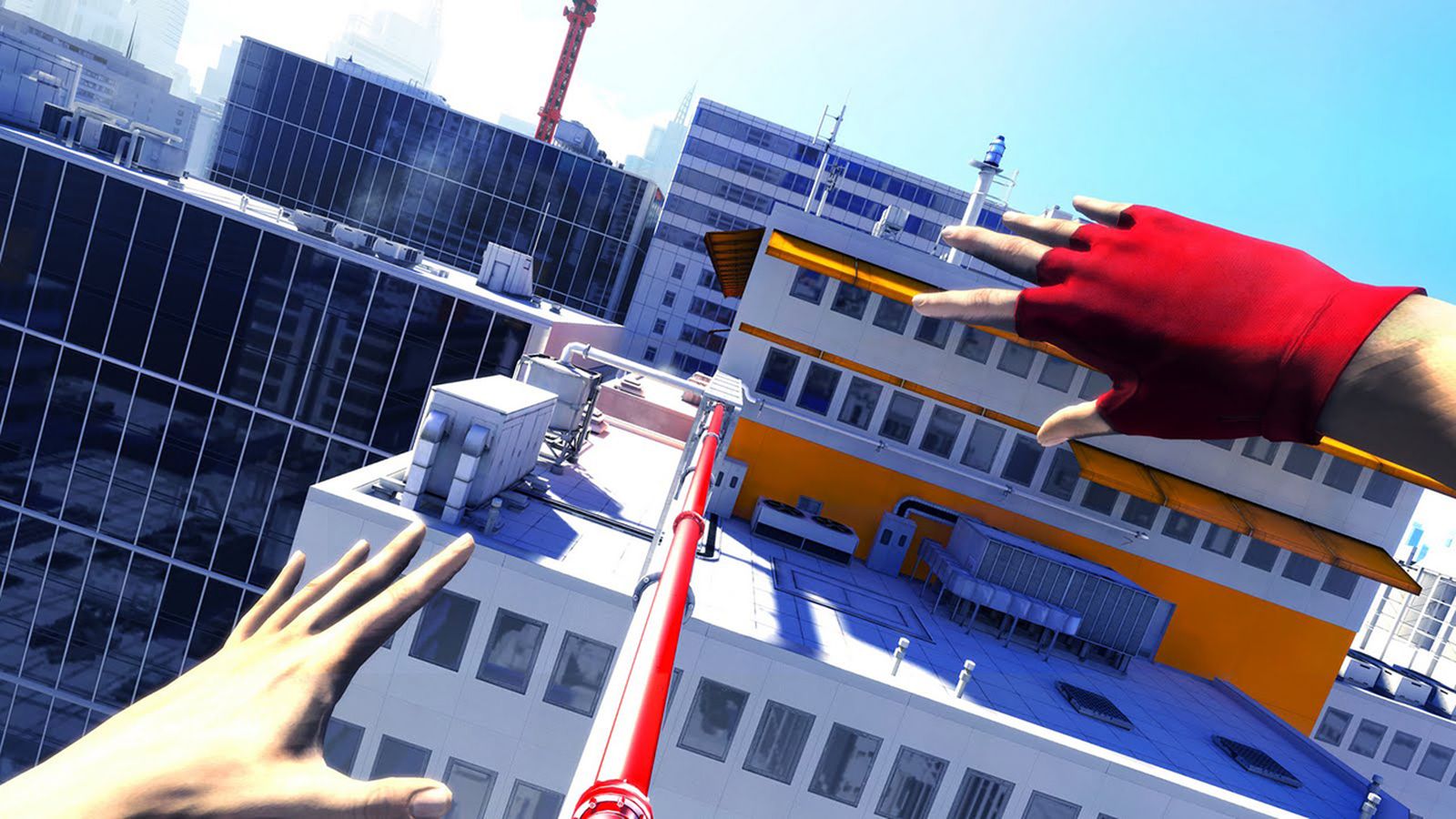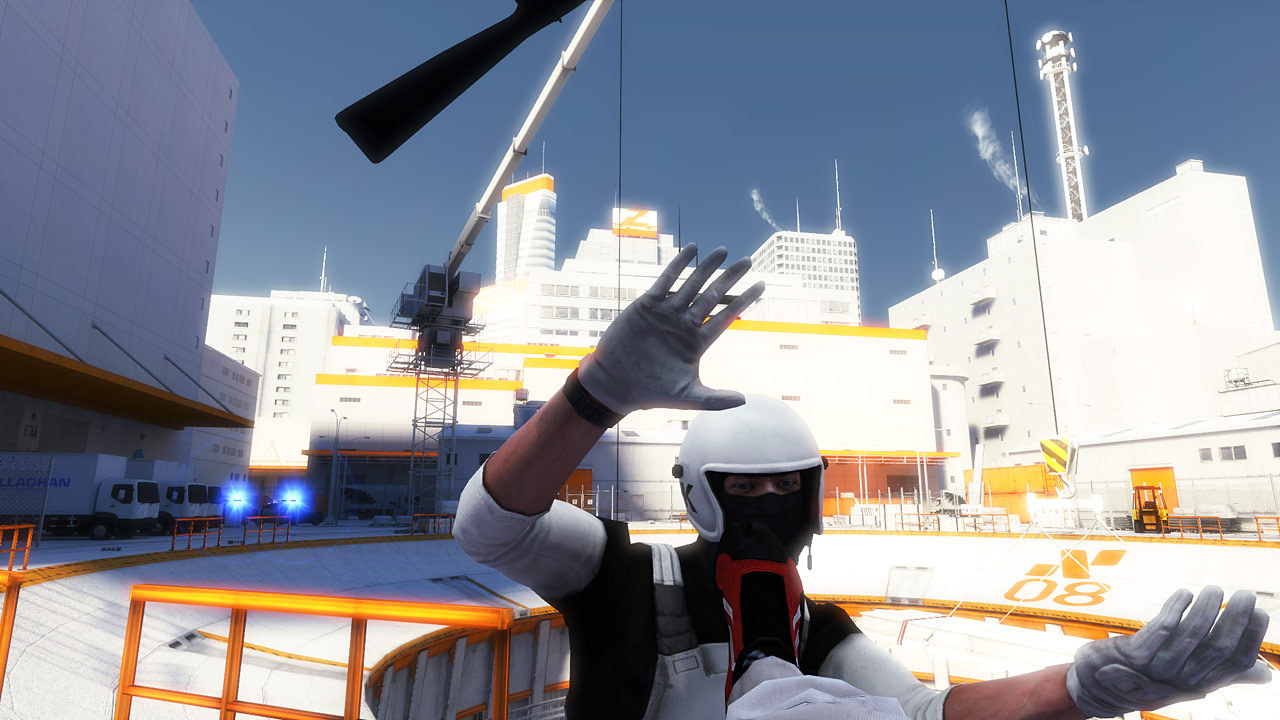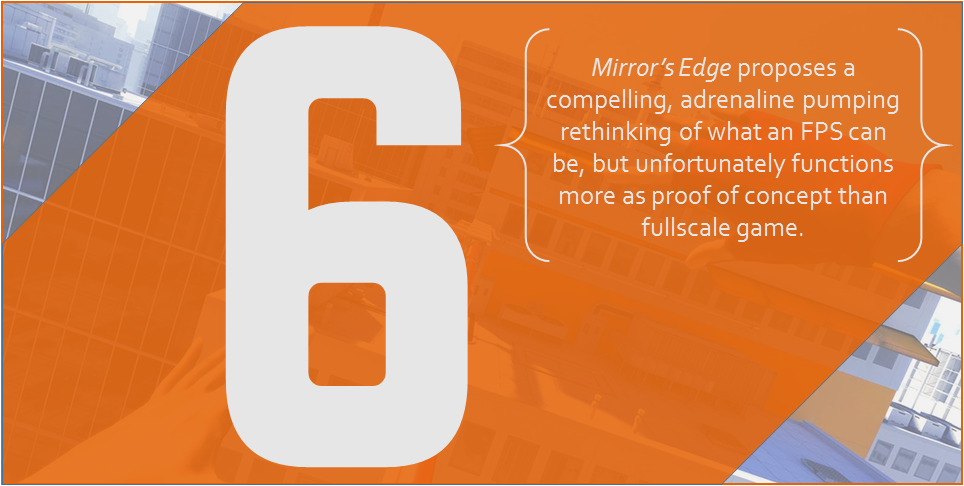Reviews in Retrospect: Mirror's Edge Remains Wonderfully Unique and Undeniably Flawed
Mirror’s Edge consistently feels like the point of impact for two diverging strains of game design. There is, first, the game Mirror’s Edge would propose itself to be, a first-person parkour escapade through a city overrun by corporate interest. It’s a crunchy, mechanics focused affair sold on the adrenaline rush that is leaping off a rooftop and hitting the ground in an effortlessly smooth, lifesaving roll. Where games such as Assassin’s Creed and Prince of Persia employ parkour as a flashy means to a navigational end, Mirror’s Edge obsesses over the act of putting one foot in front of the other; a roll here, a leap there, each action a purposeful and considered exertion meant to carry you forward as fast as possible with as little surface friction as can be managed.
The precision Mirror’s Edge demands of you in controlling your character’s body is at once overwhelming and exhilarating. I routinely felt as if the game demanded more of me than its simple over/under controls allowed for, but then I would flawlessly string together a series of moves and everything would snap into place. There is a delicate balance struck between contextual automation and player driven navigation in how you traverse the industrial playgrounds that make up Mirror’s Edge’s levels, and more often than not the choice to keep the actual controls simple pays off and helps make for a game that feels both smooth and tactile.
Problems arise though when Mirror’s Edge’s level designs fail to match the intuitive nature of its controls. There is a distinct visual vocabulary at work in Mirror’s Edge that seeks to clue you in on what can and can’t be climbed, jumped, and run on, familiar objects and situations giving way to habitual movements that streamline the planning phase and keep you moving. But despite what attempts Mirror’s Edge makes to help teach you how to read levels, by and large they remain entirely opaque. I might recognize a piece of geometry, but rarely did that translate into me knowing how to actually use it to move forward, and again and again I would find myself having to slow down and deconstruct a level before I could move forward.

This stop-and-go workaround is certainly functional, but it goes entirely against the way Mirror’s Edge seems designed to be, and how it wants you to play. For a game built with speed and flow as top priorities, Mirror’s Edge does a poor job ensuring you ever make it through a level without needing to first memorize its layout and the sequence of moves needed to successfully navigate it. It’s not impossible to get good at Mirror’s Edge and capitalize on its promises, but doing so requires such an investment of time and energy spent beating yourself against its inscrutable exterior, that it hardly feels worth it. I never expected to reach speedrun level proficiency without putting in the effort, but Mirror’s Edge fails to accommodate for players who fall anywhere outside the hyper dedicated and skilled, without feeling as if that exclusion is an intentional choice. I don’t believe developer DICE wanted Mirror’s Edge to be as hard and frustrating as it ultimately became, but perhaps that is just what happens to games that move as fast and are as demanding as this.
But I feel as if most of Mirror’s Edge’s failings are less the result of design oversights than they are the splintering of priorities. I said earlier that Mirror’s Edge feels like two strains of game design, and that second side comes into play in all the ways Mirror’s Edge either fails to flesh out the parts one would believe to be most important, or the things it chooses to include for no discernible reason. The much maligned combat is likely the biggest offender in this regard. You are rarely forced to engage with enemies, but not doing can often make the game more challenging than it is worth. Often I ran into situations where I would die dozens of times without making it through, only to reluctantly pick up a gun and be out in a matter of moments.
The reason combat is so annoying then is the same reason much of the game becomes a frustrating slog the further you progress: it keeps slowing you down. There is also the added fact that combat, while technically functional, is horrifically clunky and unsatisfying, with kicks and punches being by far the least controlled actions you perform in the game, and the gunplay feeling loose and awkward (which is especially strange given DICE’s shooter roots). It all feels like a last second inclusion, as if someone high up at EA saw the game running and became worried that no one would buy a game without combat. One can only speculate as to the various hierarchies at play in Mirror’s Edge’s development, but that doesn’t change how wholly alien the combat feels to the rest of the game, and its inclusion means that at some point development time was being allocated to it over the rest of the game (the end result being the game we received).

That isn’t to say that if DICE had opted-out of combat they would have been able to fix all of Mirror’s Edge’s problems, but when so much of the game feels rushed it seems hard to imagine that time couldn’t have been better spent elsewhere. The campaign itself is brief even by shooter standards at anywhere from 4-6 hours, and is made to feel more insubstantial due to being married to a narrative that is structurally akin to a show billed for 24 episodes that got cut down to 12. There is a framework here setting up a fascinating near future, where the control of information is paramount, and the only way to get messages relayed outside the government’s prying eyes is to use runners who carry them by hand. Our lead, Faith, is a quintessential sentimental rebel, enacting what eventually becomes an outright war between the city higher-ups and the runners in order to rescue her sister after being framed for a crime.
There is a lot to work with in Mirror’s Edge’s setting and premise, but events are strung together with so little continuity and character development that the result is something of a mess. Much of Mirror’s Edge’s plot seems to hint at a history that is never explained, with character relationships never getting much attention even as they switch sides at the drop of a hat without any legitimate justification. Eventually things boil down to a blur of small-scale politics with big ramifications, plot holes that make for easy conclusions, and an overarching storyline that by the end seems to have gone nowhere despite everything that unfolds. I am a sucker for Marxist dystopian nightmares and would have loved to learn more about Faith’s world and how she fits into it. It is incredibly rare we get a female lead in games, which makes it perhaps more frustrating than it would otherwise be that Mirror’s Edge does nothing much to develop Faith as a person. I appreciate her being here and DICE avoiding most of the pitfalls that developers fall into in creating female characters, but that only serves to illustrate just how dire things are in games even so many years after Mirror’s Edge’s release, that even being a lousy character in her own right Faith still constitutes one of the better leading ladies in a major release.
Final Word
Mirror’s Edge is an experience that few games have come anywhere near replicating. Its blend of high-contrast visuals and a visceral sense of movement and impact can be incredibly exhilarating once you learn how to make use of what you’re given. However compelling a concept Mirror’s Edge might be though, its execution is so flawed as to make playing it often far less enjoyable than the idea of doing so. With a sequel on the horizon it will be interesting to see if DICE learned anything from Mirror’s Edge relative failure, but until then it exists more as a curiosity than a classic; cool ideas not enough space to breath.


